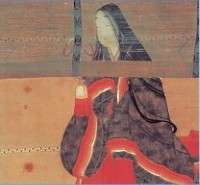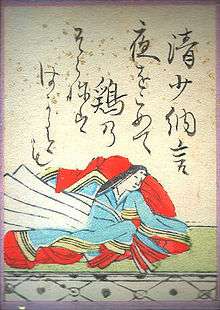The Pillow Book

The Pillow Book (枕草子 Makura no Sōshi) is a book of observations and musings recorded by Sei Shōnagon during her time as court lady to Empress Consort Teishi (定子) during the 990s and early 1000s in Heian Japan. The book was completed in the year 1002.
The work of Shōnagon consists of a collection of essays, anecdotes, poems, and descriptive passages that have little connection to one another except for the fact that they are ideas and whims of what Shōnagon was thinking of in any given moment in her daily life. In it she included lists of all kinds, personal thoughts, interesting events in court, poetry, and some opinions on her contemporaries. While it is mostly a personal work, Shōnagon's writing and poetic skill makes it interesting as a work of literature, and it is valuable as a historical document. Shōnagon’s writing in The Pillow Book was originally meant for her eyes only, but part of it was revealed to the Court by accident during her life; this occurred “when she inadvertently left it [her writing] on a cushion she put out for a visiting guest, who eagerly carried it off despite her pleas." [1] She wrote The Pillow Book as a private endeavor of enjoyment for herself; it seemed to be a way for her to express her inner thoughts and feelings that she was not allowed to state publicly due to her lower standing position in the court. Shōnagon never intended for her work to be viewed by an audience or to be read by eyes other than her own, although this was not the case, considering her work has become a famous piece in most of literature throughout the centuries. The book was first translated into English in 1889 by T. Purcell and W. G. Aston. Other notable English translations were by Arthur Waley in 1928, Ivan Morris in 1967, and Meredith McKinney in 2006.
Overview
Starting with the "exhaustiveness" of the "collection of similar things" and how it is represented by "as for worms", "as for the flowers of trees", "hateful things", and "things of beauty" – which have been described as "Borgesian lists"[2] – author Sei Shōnagon’s "Ramblings" observed the nature of everyday life and the four seasons, and described in diverse sentences "her recollections" (her diary) that look back at the society of the imperial court surrounding Empress Teishi whom she served, among other things.
According to Meredith Mckinney in the Kyoto Journal article, (who contributed to the translation of The Pillow Book from Japanese into English), The Pillow Book is a special case, and it is a genre-bending miscellany of short, largely unrelated pieces.[3] Shōnagon’s writing is categorized into three parts; the first consists of narratives, which focus mainly on the events that she witnessed and experienced during her time in the court, the second consists of her own thoughts and opinions on various matters and topics, and the third were the famous lists, or headings, with one example from Shōnagon’s writing being “Things That Make the Heart Grow Fonder.” The Pillow Book consists of 164 of these lists total, where they range from aesthetically pleasing items to being less diplomatic than Shōnagon’s anecdotes. Three types of classification were proposed by Kikan Ikeda.[4] However, there are sections that are rather ambiguous and are difficult to classify (e.g., in the first paragraph of her ramblings, "As for Spring, (it is) the dawn [that is lovely]", there are objections to common opinions of what is actually meant here).
It is composed primarily in Japanese hiragana, which is a syllabary that is actually derived from Chinese characters, and generally many of her short stories were written in a witty literary style. This style of writing was the native tongue for women in that time period and was used more often by women like Shōnagon. According to Matthew Penney in his critiquing article “The Pillow Book”, the only Chinese terms that actually appear in The Pillow Book are in the place-names and personal titles, and the rest is classified as original hiragana.[5] Confessions of her personal feelings are mixed into her writing with occasionally subtle sentimentality that reflects the downfall of the emperor’s adviser, Fujiwara no Michitaka (her biological father), as well as the misfortune of both Emperor and Empress Teishi.
Both the author's sophisticated sense and her eye for particular things are fused; for if one compares the sentimentality of mono no aware (the Pathos of Things) as found in "The Tale of Genji", similar beauty of the world is revealed through the use of the intellectual word okashi (lovely) in this piece.
In general, this piece is written in brief statements, where the length of one paragraph is relatively short, and it is easy to read the contents, even for modern Japanese speakers. The miscellaneous collection has been arranged loosely into three specific types, while the collection of similar things has been compiled by distinct classification, and this so-called compiling was done afterwards by the hands of people other than Sei Shōnagon. Based on the beliefs of certain scholars, most of Shonagon’s work was written during her time working in the court; however, some of the later entries were written in her later life, and were just based on her memories of the days and moments she experienced previously in the court.
An aspect that makes Shōnagon’s writing in The Pillow Book different from other written diaries of her period and even modern day journals is the fact that she did not invest her time in soul-searching, nor was she searching for the attention or opinions of readers, simply because she did not invest in her writing for others, but only for herself. Shōnagon’s focus in The Pillow Book is based on the likes and dislikes of the world, what she is interested in personally, and the delightedness of the world that she viewed and lived in. In the Kyoto Journal article, McKinney explains that Shōnagon is “engaging you [the reader], face to face across the centuries, assuming your familiarity with her and her world, compelling you to nod and smile.” [6] The selections in this anthology are meant to showcase the variety of Shonagon’s musings and anecdotes (457 “The Pillow Book”). “The Pillow Book” is a collection of anecdotes, lists, and assorted writings that is one of the best sources of information concerning the court society of the tenth century and is considered an influential landmark in the history of Japanese Literature (Penny and Matthew). “The Pillow Book” is written entirely in Japanese. During the late tenth and early eleventh centuries, Japanese men typically wrote in Chinese, using characters, while Japanese women wrote exclusively in their native tongue, using hiragana, a syllabary derived from Chinese characters (Penney and Matthew). “The Pillow Book” is a part of a large tradition of women’s literature. The simplicity and charm of Shonagon’s style has been used as an example of the finest Japanese prose to this day. Sei Shonagon has been described as arrogant and confrontational by many readers, according to Penney and Matthew. Though they describe her as freely expressing her feelings with sharp wit. “The Pillow Book” influenced a genre of Japanese writings established as zuihitsu (assorted writing). Zuihitsu, many writings share Sei Shonagon’s passion to capture the quintessence of day-to-day life, it is popular in the Japanese publishing industry.
The Heian Period
The Heian period was essential to the aristocratic people. Poetry and vibrant art were a big part in the imperial court, of which Shonagon was a part (“The Heian Period”). The people in the imperial court were expected to be well educated in writing. Literature was seen as a “key part in social interaction” (“History of Japan”). One’s writing skills could make or break their reputation. For example, Shonagon mentions in The Pillow Book how a courtier asked her for advice for writing a poem and she had to turn him away because of his poor writing skills (Sei Shonagon). During the Heian period, women had a role in society...especially those women who were considered to be upper-class (Reese). Female authors in Japan during this time were more popular since they wrote in Japanese, which was considered the “people’s language,” and the male authors wrote in Chinese since that was considered to be of higher status (Reese). With regards to female author’s works being more popular to the common people, it is safe to assume that their works were influential to the society.
Other pillow books

More generally, a pillow book is a collection of notebooks or notes which have been collated to show a period of someone or something's life. In Japan such kind of idle notes are generally referred to as the zuihitsu genre. Other major works from the same period include Kamo no Chōmei's Hōjōki and Yoshida Kenkō’s Tsurezuregusa. Zuihitsu rose to mainstream popularity in the Edo period, when it found a wide audience in the newly developed merchant classes. Furthermore, it gained a scholarly foothold, as Japanese classical scholars began customarily writing in the zuihitsu style. Reputable authors from this movement include Motoori Norinaga, Yokoi Yayu, and Matsudaira Sadanobu.[7]
Peter Greenaway released his film The Pillow Book in 1996. Starring Vivian Wu and Ewan McGregor, it tells a modern story that references Sei Shōnagon's work.
The Pillow Book is also the name of a series of radio thrillers written by Robert Forrest and broadcast on BBC Radio 4's Woman's Hour Drama. These are detective stories with Sei Shōnagon as a principal character and feature many of her lists.[8]
See also
- Heian literature
- Nikki bungaku
- The Dog Pillow is an Edo period parody.
References
- ↑ McKinney, Meredith. "Meredith McKinney on Sei Shonagon's Masterpiece." Kyoto Journal. http://www.kyotojournal.org/the-journal/in-translation/on-translating-a-classic/. Accessed 13 Feb. 2017.
- ↑ Liza Dalby (1 February 2009). East Wind Melts the Ice: A Memoir Through the Seasons. University of California Press. p. 22. ISBN 978-0-520-25991-1.
- ↑ McKinney, Meredith. "Meredith McKinney on Sei Shonagon's Masterpiece." Kyoto Journal. http://www.kyotojournal.org/the-journal/in-translation/on-translating-a-classic/. Accessed 13 Feb. 2017.
- ↑ 池田亀鑑, Complete Lectures on The Pillow Book (全講枕草子』解説), 1957
- ↑ Penney, Matthew. "The Pillow Book." Discover Galileo. Salem Press Encyclopedia, 2016. http://eds.a.ebscohost.com/eds/detail/detail?vid=3&sid=999b346e-ba65-458e-b323 1e6713af218e%40sessionmgr4010&hid=4202&bdata=JnNpdGU9ZWRzLWxpdmUmc2NvcGU9c2l0ZQ%3d%3d#AN=89454036&db=ers. Accessed 13 Feb. 2017.
- ↑ McKinney, Meredith. "Meredith McKinney on Sei Shonagon's Masterpiece." Kyoto Journal. http://www.kyotojournal.org/the-journal/in-translation/on-translating-a-classic/. Accessed 13 Feb. 2017.
- ↑ Kodansha Encyclopedia of Japan
- ↑ "Woman's Hour Drama, The Pillow Book, series 3". BBC. Retrieved 16 November 2010.
Bibliography
- Sei Shōnagon (2006). The Pillow Book. trans. Meredith McKinney. London: Penguin Books. ISBN 0-14-044806-3.
- Sei Shōnagon (1971). The Pillow Book of Sei Shōnagon. trans. Ivan Morris. London: Penguin Books. ISBN 0-14-044236-7. Originally published in 1967 by Columbia University Press.
- Sei Shōnagon (2011). The Pillow Book of Sei Shōnagon, the Diary of a Courtesan in Tenth Century Japan. trans. Arthur Waley. Rutland, Vermont: Tuttle Publishing. ISBN 978-4805311080.
- Henitiuk, Valerie (2011). Worlding Sei Shônagon: The Pillow Book in Translation. Ottawa: University of Ottawa Press. ISBN 978-0-7766-0728-3.
Penney, Matthew. “The Pillow Book.” Salem Press Encyclopedia 2016: Research Starters.Web.21.Feb.2017
Reese, Lyn. Heian Period. Women In World History Curriculum. www.womeninworldhistory.com/Heian9.ht Accessed 27 February 2017.
External links
| Japanese Wikisource has original text related to this article: |